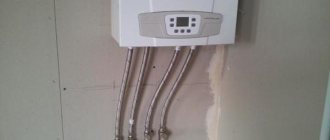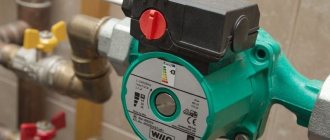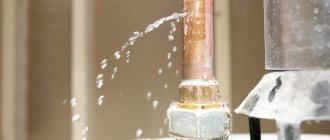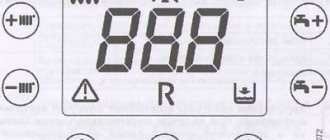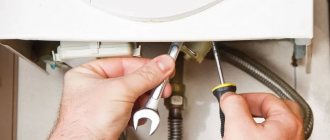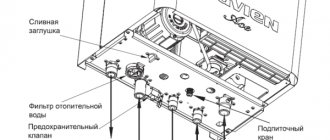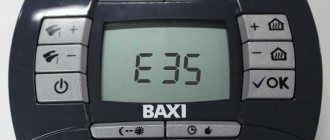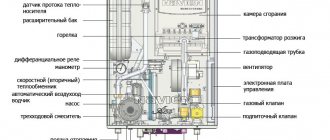Regardless of the brand of water heater and its cost, breakdowns will occur sooner or later. Most of them have nothing to do with the operating features, but it would be stupid to exclude the possibility of a malfunction due to the fault of the user himself.
Each water heater, due to its design features, has certain breakdowns, but most of them can be prevented or corrected independently. The main thing is to follow clear instructions and maintain maximum safety.
Causes of breakdowns
The most common causes of water heater malfunctions are the following:
- Sudden power surges in the network lead to burnout of contacts in the heating element, rendering it inoperable.
- Incorrect installation and connection, lack of grounding - the water heater is operated in conditions not intended for favorable operation, which significantly reduces its service life.
- Lack of maintenance - if the water heater is not cleaned of sediment that accumulates due to contaminated water, then sooner or later it will reduce efficiency, after which it will completely fail.
If we consider water heaters from the point of view of their design, then there are two types:
- Storage (boiler) - water from the general system is supplied to a storage tank, where it is heated to the required temperature and, on demand, discharged into a separate hot water supply pipeline. Heating is carried out using an electric heating element, and to prevent the development of corrosion, a magnesium anode is used, which needs periodic replacement.
- Flow-through - water is heated directly as the flow passes through the device. There are electric and gas ones, in which the heating power is much higher than that of storage ones.
Water heaters also differ in volume, power and brand. Cheaper models are made from the most affordable materials, but their service life is quite limited. A good and reliable option will cost the buyer a little more, but with timely cleaning it will last for many years.
Device structure
The classic design of a water heater is presented in the form of a sealed tank. Inside the container there are elements that are needed to heat water and ensure long-term and safe operation of the device. Typical products consist of several main elements:
- frame;
- insulating coating;
- tank;
- magnesium anode;
- inlet tubes;
- temperature sensors.
In this video you will learn everything about water heaters:
There is always water inside the container, so there is a risk of bacterial growth. Because of this, device manufacturers make tanks from stainless steel or treat products with titanium coating. The cheapest material is glass porcelain, and such structures quickly become unusable. There are two types of heating elements:
- Wet. Are in direct contact with water. They are often presented in the form of hollow structures, inside of which there is a heating coil. The space around the element is filled with sand or other substances with high thermal conductivity.
- Dry. Placed on the side of the tank. It is separated from contact with water by a ceramic casing. These elements are considered much safer than wet ones. This is due to the absence of scale on them, which minimizes the likelihood of a short circuit.
The fastening of heating elements can be flanged , when the elements are pressed using bolts, as well as nut - the parts are equipped with threads, the fixation is carried out by screwing. Often heating elements are steel or copper.
In our case, steel parts
The water temperature does not correspond to the specified parameters
Significant deviation of water temperature from the specified parameters
The problem arises in two cases, when the water from the heater is either too hot (literally boiling water) at minimum heating values, or cold and heating does not occur at all. There is also an intermediate malfunction, when the maximum heater values are set, and the water is slightly warm. All problems deserve attention, the causes of which can be quite numerous.
So, let's consider a situation where the water heater, at maximum values on the relay, produces only warm water in the tap, which is preceded by the following possible problems:
- The heating element is covered with scale, it consumes more energy on heating, while the efficiency is at a minimum.
- There are problems in the central board that are blocking the relay signal to the desired temperature.
If the water heater visually turns on and supposedly works, but in fact only produces cold water, then the reasons may be similar to those stated above. When the temperature of the water is exceeded, the problem lies in a malfunction of the thermostat or thermostat, which is responsible for fixing the heating parameters set by a person and maintaining this temperature inside the water heater.
If the problem is related to temperature mismatch, you need to perform the following sequence of actions:
- Check the heating element for contamination and proper operation : disconnect the boiler from the mains, allow the water to cool and drain it as much as possible, then remove the protective cover at the bottom, open the valve and carefully remove the heating element. Using a multimeter, check the functionality of the element, which is fixed in the range of values 0.68-0.37 Ohm. If there is a break, the indicators will be unstable and will tend to infinity. If there is scale, it can be removed by soaking it in a special acid solution, which can be bought at any household store. Apple cider vinegar is an alternative.
- Take out the thermostat and evaluate its performance : disconnect the boiler from the network, drain the water, remove it from the wall. Find the thermostat (you can see in the instructions what it looks like and where it is located for a specific model) and press the safety button all the way. Next, the metal tube needs to be slightly heated with a lighter. If the thermostat is working, then when it heats up it will react and return the button to its original position. If this does not happen, then you should completely dismantle and replace the element with a new one.
Similarly, you should go through all available contacts with a multimeter, since there is a possibility of a break, which provokes a lack of proper operation.
Expert opinion
Grebnev Vadim Savelievich
Heating system installer
Before draining the water, you need to let it cool. If you don’t have time to wait, then the following trick will do: open the hot water tap to maximum, unplug the boiler. After about 5-7 minutes, the water in the tank will become slightly warm, which will facilitate the process of draining it.
Cleaning the heating element
To clean the heating element of the water heater from scale, use the means at hand: a metal brush, a knife, etc.
Has your boiler started making noise like an electric kettle? Does it heat the water poorly, continuously consuming kilowatts of electricity? The scale covering the surface of the heating element is to blame. It has low thermal conductivity, so heat from the heater is practically not transferred to water. As for the noise, it is the noise of the water in the thickness of the scale itself. Thus, all scale from here needs to be removed. We begin repairing the boiler by draining the water, then remove the water heater from the wall, remove the heating element and begin cleaning it.
Cleaning heating elements from scale can be done in various ways. The mechanical method involves removing the main layer of scale by hand while it is still wet. After this, we take sandpaper in our hands and carefully remove the remaining lime deposits from the heating element. As a result, we should get a clean and shiny heating element.
The mechanical method implies a careful approach - the heating element must be cleaned as carefully as possible so as not to make unnecessary holes in it. There is no need to hit the heating element on hard surfaces - this way it can be completely broken.
The chemical method involves the use of special reagents that dissolve or soften scale. They can be purchased at hardware stores, but be sure to check consumer reviews first. As for strong acids, it is better not to use them - they can damage the metal of the heater.
Leak in tank
The problem of leak development is associated with corrosion of the metal, which is constantly in contact with water. If you do not change the magnesium anode, as required by the manufacturer, then after a couple of years you can see clear signs of depressurization. In 95% of cases, it will not be possible to eliminate this problem, since the design of the tank requires tightness, which can only be achieved in a factory environment.
A leak in the tank is almost impossible to fix on your own; a complete replacement may be required.
Self-repair is only appropriate if the leak appears exclusively from under the flange. This happens when the gasket, which creates a seal on the outside of the heating element, is worn out.
The sequence of actions in this case is as follows:
- Disconnect the boiler from the mains, let the water cool and drain it as much as possible.
- Remove the lid, place the container and carefully open the valve, removing it along with the heater.
- Inspect the rubber valve for deformations and abrasions.
- Replace it by first disconnecting it.
If drops of water collect along the contour at the bottom of the boiler, then this cannot be corrected. Craftsmen will tell you that there is also welding that will allow you to quickly and reliably seal the hole. But this is inappropriate in the case of closed-type boilers, since the design does not imply access to the outside of the internal tank. It would be appropriate to replace the water heater with a new one.
Removing scale
After you empty the tank, you will need to disassemble the boiler yourself. To do this, carefully disconnect all the fastons connected to the thermostat and unscrew the bolts, of which there are usually 6 pieces.
When removing the heating element, some more water that remains in the tank will pour out. It is recommended to clean the heating element itself immediately, while it is wet and scale deposits have not hardened. For cleaning, we recommend using special products that can be sprayed onto the heater. After some time, the deposits can be easily removed with a wooden spatula or even a dull knife. Also, for repairs, you can boil the heating element in a bucket with the addition of a special acid to the water, which will effectively solve the problem. To be sure to get rid of scale, we recommend using fine-grained sandpaper (“sandpaper”) to clean the tubes to a metallic color.
Simultaneously with the repair of a boiler that heats water for a long time or poorly, it is recommended to replace the magnesium anode, which protects the tank from corrosion. To do this, dismantle the worn rod and purchase exactly the same one so you can replace it yourself!
After this, you need to reassemble the boiler in the reverse order and check whether the weak water heating was repaired. Do not forget that first of all you must fill the tank completely with water, after which you will connect the plug to the power supply and start.
We draw your attention to the fact that there is a situation when the boiler does not heat the water because the heater is broken. In this case, self-repair consists of testing it with a multimeter, setting the resistance measurement mode. We will tell you about this below!
Boiler does not turn on
If there is no heating when inserting the plug into the socket, there may be several reasons:
- The heating element has burned out or there are broken contacts, which occurs with frequent sudden changes in voltage in the network.
- The elements of the central board , which control the operation of the entire water heating system, burned out.
- Malfunction of the thermostat , which records false readings of water and eliminates the need to heat it.
What can and should be done in this case:
- Inspect the heating element and evaluate its performance using the device - disconnect from the network, drain the water and carefully unscrew the safety valve. If it is faulty, it needs replacement. This problem is most common in closed type water heaters.
- Go through the thermostat contacts: disconnect from the network, you don’t have to drain the water, remove the protective cover and ring all connections, including the central board. If the indicators are far from normal, then repair is required. If the thermostat can be replaced with a similar one yourself, then this will not work with the board. You'll have to call a technician, but he doesn't guarantee that the boiler will work.
You also need to check the serviceability of the plug. It often happens that the wire breaks and the contacts are compressed, forming a short circuit.
Expert opinion
Grebnev Vadim Savelievich
Heating system installer
It is better to allocate a separate outlet for the boiler, next to which no other devices will be connected to the network. This will reduce the risk of overheating and also eliminate the possibility of a short circuit.
Problems with the supply of hot water in a gas boiler
There are several main water heater malfunctions in this area:
- There is no supply of hot liquid. It is necessary to check the gas supply and the burner. In the case of electronic ignition, you also need to pay attention to the serviceability of the fuses.
- The water is not heating up enough. First, they also check the equipment for fuel supply and burner activation. If this is not the reason, pay attention to the thermostat, which may not be adjusted correctly. On burners with electronic ignition, check the fuses and switch.
- The water is not warm enough. The reasons are the same: malfunction of the thermostat or excessive fluid consumption. For example, if the boiler volume is 40 liters, then it is necessary to calculate no more than 30 liters for hot water supply.
- Low fluid supply pressure. Check whether the inlet valve is completely open, as well as the diameters of the pipes in use.
The boiler body is electrocuted
If you accidentally come into contact with the heater, you may notice how it transmits a discharge. It may not shock much, but it is quite unpleasant. One reason is the direct contact of electricity with water. This happens due to a crack in the heating element, which is caused by accumulated scale. When the boiler is connected to the network, not only its body, but also the flowing water can carry a charge.
If the body of the water heater is electrocuted, then it is necessary to check the heating element
In this case, it is necessary not only to check the heating element and, if necessary, replace it, but also to ensure proper grounding of the electrical appliance. If this causes difficulties, then it is better to entrust the repair to a specialist.
It is extremely unsafe to use a hot water heater. Sooner or later this will provoke a global breakdown or cause health problems.
When to call a specialist
When the water heater stops heating water, it immediately becomes clear that it is faulty. However, sometimes this is noticeable indirectly, the automation simply regularly knocks out, the RCD is triggered, and upon contact with water it gives an electric shock. All this also indicates a faulty boiler. Of course, in most cases you can repair a water heater yourself, but there are times when you need to call a specialist.
There are breakdowns that only a professional can fix.
Such breakdowns include the following:
- an almost new boiler shuts down unexpectedly;
- The settings on the thermostat are constantly reset;
- The RCD is constantly tripping;
- The water heater bulb is leaking.
It is worth noting that in the latter case, repairs are rarely effective; it is better to purchase a new boiler. Of course, you can replace the magnesium anode yourself, but it is better to entrust it to specialists by contacting a service center.
Dirty and foul-smelling water from the heater
If, when you turn on the hot water, something similar to kvass flows out of the tap, having a characteristic swamp smell, then it’s time to clean the heater. This situation occurs when sediment accumulates inside a closed tank and flows through the pipes. Visually this may not be noticeable, but debris tends to accumulate and settle not only on the heating element, but also on the walls of the boiler.
The problem should be solved in two stages:
- Place a filter at the cold water inlet: it will trap debris and dirt, as well as bacteria that can live in a closed tank system. The water will become much cleaner, and preventative cleaning of the boiler will be needed less often.
- Clean the boiler: you can pour special disinfectant solutions through the supply tube, then drain the contents into a bucket. There are a lot of special products to clean your boiler.
The cleaning procedure will not cause any particular difficulties. The sequence of actions depends on the chosen tool:
| Name | Quantity | Sequencing |
| Lemon acid | 20 g of powder for every liter of water | Mix the required amount of citric acid with 2 liters of water, then introduce the solution through the water supply hose. Plug in and set the maximum values on the relay. Let it boil for 3-4 hours, then open the hot water tap and completely drain the water from the boiler. |
| Vinegar essence | 10 ml for every liter of water | Vinegar should be introduced into the boiler through a hose, and then connect the hose to the pipeline. Set to maximum temperature and drain completely after 4 hours |
| Acidic solvents for cleaning boilers | Please refer to the instructions for proportions. | The product is poured into the boiler and left for 1-2 hours, after which the water is completely drained |
Principle of operation
A gas boiler operates thanks to a burner, which is located inside a metal casing and heats the water entering through the heat exchanger. The safety of this process is ensured by automation, which forces the valve to operate when the water tap is opened and pushes the gas into the burner. There, the substance lights up either automatically or by pressing a special button. Gas combustion products are discharged through the chimney.
The gas boiler can operate in a single- or double-circuit circuit
A water heater powered by an electrical network performs its task in a different way. The tank is filled with cold water from below and it is distributed inside the housing using a jet divider. The device helps to displace hot water upward and remove it through the tube.
Hot water is supplied to the bathtub and sinks
Repair of instantaneous gas water heaters
Failures are most often associated with scale fouling of the heat exchanger, as well as a malfunction of the thermocouple. Repairing gas equipment yourself is strictly prohibited. To find the cause and eliminate it, you need to contact specialists who will do everything themselves.
Expert opinion
Grebnev Vadim Savelievich
Heating system installer
In order for the equipment to last as long as possible and not require expensive repairs, it is necessary to follow the rules of its operation, as well as promptly clean the internal elements from contaminants. Preventive cleaning is indicated once a year.
Other problems
Other faults that may require water heater repairs include:
- The body of the boiler produces electric shock. Most likely, the heating element is coated with scale or cracked, causing the liquid to come into contact with the coil itself. The heating element needs to be replaced. Also, a similar manifestation occurs if the control unit is faulty or there is no grounding. It is necessary to replace the control unit or ground the device.
- The equipment does not turn on. The thermostat, heating element or control board should be checked and replaced. In addition, it is advisable to check the power supply from the electrical network.
- The boiler makes hissing and other extraneous sounds and takes a long time to heat up. It is necessary to replace the pipes with analogues of suitable diameter. If the device is used for a long period, it is necessary to carry out preventive cleaning.
General tips and tricks for DIY repairs
In order for repair work to be successful and not pose a threat to life and health, you need to:
- Inspect and replace parts only with the device disconnected from the network, after draining the water in any convenient way.
- Do not attempt to independently repair faulty parts that should be replaced with new ones.
- Carry out work based on the boiler structure diagrams, which are different for each specific model.
If ultimately the water heater does not work or is working with some problems, then it is better to call a technician who has some experience and can identify all possible causes.
Conclusions and useful video on the topic
A detailed video on diagnosing the condition, maintenance and self-repair of household water heaters can be viewed here:
Repairing a water heater is not so difficult if we are talking about replacing some of its elements. In the event of a serious breakdown, it would be wiser to contact a specialized service center. Proper operation of the device and its timely maintenance will save you from many problems and expenses.
Have you been repairing water heaters for a long time and want to supplement our material with useful tips and professional secrets for eliminating various types of breakdowns? Or is this the first time you’ve encountered a malfunction and can’t find its cause? Write your comments, ask questions, share your opinion below the article.
FAQ
The power indicator is at maximum, and the water in the boiler is not even hot, but slightly warm. What could be the reason?
There are several problems: malfunction or scale of the heating element, breakdowns in the relay or malfunction of the central board. A specialist who will diagnose all working elements will help determine the true cause (and there may be several of them).
The water quality in our region is not very good, so the magnesium anode has to be changed 1-2 times every six months. What is the alternative?
If magnesium anodes quickly dissolve and there is a risk of contamination of the heating element, then it is necessary to install a cleaning filter at the inlet of the cold water pipeline.
Sometimes the hot water from the boiler is electric. The grounding has been checked and is working properly, what could be the reason then?
It is necessary to inspect the heating element for cracks and chips. Often, if there is scale and annual salt deposits, its integrity can be compromised, allowing direct contact of water with the coil. The cause may also be faulty wiring or the inclusion of several household appliances in one outlet.
Is it necessary to periodically change the heating element or is this procedure forced?
The heating element must be replaced only if it is faulty.
In conclusion, it is worth noting that not all breakdowns can be fixed with your own hands, and in some cases it is better not to experiment at all and entrust the diagnosis to a specialist. All work must be carried out in compliance with safety rules, disconnecting the electrical appliance from the network. To prevent hot water from causing a burn, it should be drained only after it has been diluted with cold water.
General installation rules
If the issue of choosing a water heater has already been resolved, and a wall-mounted version of the electric unit has been purchased, you can proceed directly to its installation. But before that, you should consider some nuances.
- The first step is to determine the installation location of the device. The location of the unit must be such that it is easy to carry out preventive and, if necessary, repair work.
- Before installing a water heater, it is necessary to assess the condition of the water pipes. If the pipes are old, it is recommended to replace them completely or at least the insertion section.
- In the vast majority of cases, the device is mounted on the wall (an exception may be the installation of an indirect heating boiler, which can be both floor-mounted and wall-mounted), so the wall must withstand a load 2 times greater than the tank capacity. For example, with a tank volume of 100 liters, the wall must support a mass of 200 kg. Of course, drywall is not suitable for these purposes.
- If you are installing a water heater in a country house on a wooden wall, make sure it is strong.
- In addition, since the unit uses powerful heating elements, before hanging the water heater, you need to take into account that the wiring must withstand a certain load. Therefore, it is recommended to draw a separate line from the meter and install a circuit breaker in front of the device. The wire cross-section should be 2.5 mm.
Water heater on a reinforced wall of a country house



